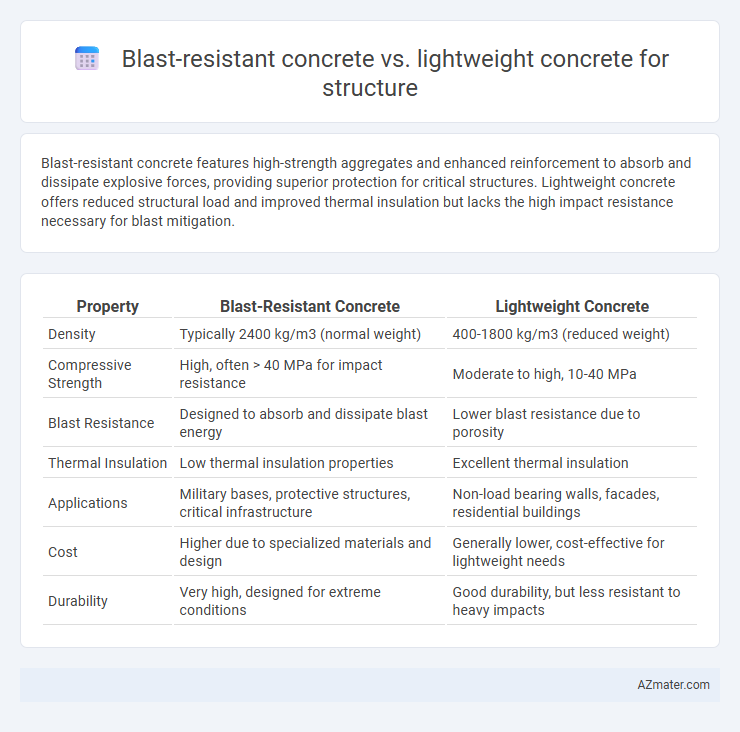Blast-resistant concrete features high-strength aggregates and enhanced reinforcement to absorb and dissipate explosive forces, providing superior protection for critical structures. Lightweight concrete offers reduced structural load and improved thermal insulation but lacks the high impact resistance necessary for blast mitigation.
Table of Comparison
| Property | Blast-Resistant Concrete | Lightweight Concrete |
|---|---|---|
| Density | Typically 2400 kg/m3 (normal weight) | 400-1800 kg/m3 (reduced weight) |
| Compressive Strength | High, often > 40 MPa for impact resistance | Moderate to high, 10-40 MPa |
| Blast Resistance | Designed to absorb and dissipate blast energy | Lower blast resistance due to porosity |
| Thermal Insulation | Low thermal insulation properties | Excellent thermal insulation |
| Applications | Military bases, protective structures, critical infrastructure | Non-load bearing walls, facades, residential buildings |
| Cost | Higher due to specialized materials and design | Generally lower, cost-effective for lightweight needs |
| Durability | Very high, designed for extreme conditions | Good durability, but less resistant to heavy impacts |
Introduction to Concrete Types in Structural Engineering
Blast-resistant concrete is engineered to withstand high-impact forces and explosive loads, featuring enhanced density and toughness compared to conventional mixes. Lightweight concrete incorporates expanded aggregates like expanded clay or shale, reducing overall structural weight while maintaining adequate strength for non-load-bearing or seismic applications. Structural engineers select blast-resistant concrete for critical infrastructure requiring high durability, whereas lightweight concrete is favored for projects emphasizing load reduction and thermal insulation.
Defining Blast-Resistant Concrete
Blast-resistant concrete is engineered to withstand high-impact forces and explosive loads, incorporating dense aggregates and specialized admixtures to enhance strength and energy absorption. Its composition prioritizes high compressive strength and toughness to prevent spalling and structural failure during blasts. Contrastingly, lightweight concrete focuses on reduced density and thermal insulation, sacrificing some impact resistance for weight savings.
Overview of Lightweight Concrete
Lightweight concrete, characterized by its lower density ranging from 1,440 to 1,840 kg/m3, offers enhanced thermal insulation and reduced dead load in structural applications. It typically incorporates lightweight aggregates such as expanded clay, shale, or pumice, improving workability and reducing overall structural weight. This type of concrete is advantageous in seismic zones and high-rise buildings where weight reduction is crucial without compromising strength and durability.
Key Material Properties: Strength and Density
Blast-resistant concrete exhibits high compressive strength typically ranging from 40 to 100 MPa, combined with increased density around 2400 kg/m3, providing superior energy absorption during explosions. Lightweight concrete, with densities between 1400 to 1850 kg/m3, offers reduced dead load advantages but generally has lower strength values, often between 17 and 35 MPa, limiting its blast resistance capabilities. Selecting concrete for structural applications requires balancing strength and density, where blast-resistant concrete ensures enhanced durability under extreme loading conditions while lightweight variants optimize weight reduction.
Performance Under Blast Loads
Blast-resistant concrete exhibits superior performance under blast loads due to its high density and enhanced energy absorption capabilities, significantly reducing structural damage and fragmentation. Lightweight concrete, while offering benefits in reducing dead load, generally lacks the necessary mass and strength to effectively mitigate blast pressures and impulse effects, resulting in lower blast resilience. Optimizing mix design with fibers and additives can improve blast resistance in both types, but standard blast-resistant concrete remains the preferred choice for critical protective structures.
Structural Applications and Suitability
Blast-resistant concrete exhibits high density and enhanced compressive strength, making it ideal for protective structures subjected to explosive loads, such as military bunkers and critical infrastructure. Lightweight concrete offers reduced dead load and thermal insulation, suitable for non-load-bearing elements and structures where weight savings are crucial, like high-rise buildings or seismic zones. Structural applications require assessing specific performance criteria including impact resistance and load capacity to determine suitability between blast-resistant and lightweight concrete.
Cost Implications and Construction Challenges
Blast-resistant concrete offers superior durability and enhanced safety but comes with higher material and labor costs due to its specialized additives and dense composition. Lightweight concrete reduces structural load and construction time, lowering overall expenses, yet it presents challenges such as reduced strength and potential difficulties in achieving uniform quality. Balancing cost implications against performance requirements is critical when choosing between blast-resistant and lightweight concrete for structural applications.
Durability and Long-Term Performance
Blast-resistant concrete exhibits superior durability due to its dense microstructure and enhanced toughness, providing exceptional resistance to high-velocity impacts and explosive forces. Lightweight concrete, although offering benefits in reduced structural load and thermal insulation, typically has lower compressive strength and may exhibit increased permeability, which can affect its long-term performance under aggressive environmental conditions. Optimizing mix design and incorporating supplementary cementitious materials can improve the durability and lifespan of both concrete types in structural applications.
Environmental Impact and Sustainability
Blast-resistant concrete uses specialized aggregates and fiber reinforcements to enhance durability and safety in explosive environments, often resulting in higher embodied energy due to the use of dense materials and additives. Lightweight concrete, made with expanded clay, shale, or pumice, reduces the structural load and improves thermal insulation, thereby lowering energy consumption during the building lifecycle and reducing carbon emissions. The sustainability of lightweight concrete is generally greater because it decreases material use and promotes energy efficiency, whereas blast-resistant concrete prioritizes safety with a higher environmental footprint.
Conclusion: Choosing the Right Concrete for Structural Needs
Blast-resistant concrete offers superior impact and explosive load resistance, making it essential for high-risk structures like military facilities or critical infrastructure. Lightweight concrete provides advantages in reducing dead load and improving thermal insulation, ideal for multi-story buildings and seismic zones. Selecting the right concrete depends on balancing structural safety requirements with performance factors such as load-bearing capacity, weight, and environmental conditions.

Infographic: Blast-resistant concrete vs Lightweight concrete for Structure
 azmater.com
azmater.com